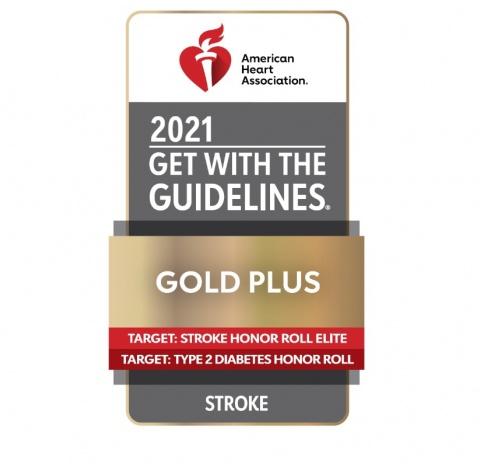
Duke University Hospital and Duke Raleigh Hospitals have received the American Heart Association’s (AHA) Get With The Guidelines®-Stroke 2021 Gold Plus Quality Achievement Award. This award, the highest that the AHA offers, recognizes commitment to providing the best possible care for stroke. Both Duke University Hospital and Duke Raleigh Hospital have received this award from the AHA for the past three years.
“These awards reflect excellence, teamwork, and dedication to comprehensive stroke care across the hospital system,” said Wayne Feng, MD, MS, Chief of the Division of Stroke and Vascular Neurology at the Duke University School of Medicine. “Every day ambulance paramedics, emergency department providers, stroke neurologists, vascular neurosurgeons, imaging technicians and neuroradiologists, pharmacists, nurses and countless others come together to provide care quickly, effectively, and according to the latest nationally recognized, evidence-based guidelines.”
Stroke is the fifth-leading cause of death and a leading cause of adult disability in the United States. On average, someone in the United States suffers a stroke every 40 seconds, and nearly 795,000 people suffer a new or recurrent stroke each year. Rates of stroke are disproportionately high in North Carolina and other states in the “stroke belt” that spans the Southeast. People living in the stroke belt have higher stroke incidence and stroke mortality. Early stroke detection and treatment are key to improve survival, and speed recovery times, minimize disability, and enhance quality of life.
Duke University Hospital also met the joint commission accreditations as a Comprehensive Stroke Center and Duke Raleigh Hospital as a primary stroke center, featuring a comprehensive system for rapid diagnosis and treatment of stroke patients admitted to the emergency department. Duke University Hospital stroke center also provides acute stroke care to rural areas in North Carolina and Virginia through an eight hospital tele-stroke network. Despite the COVID19 pandemic last year, among 2498 stroke consults, 240 stroke patients received thrombolytics, and 43 patients received endovascular treatment at Duke.
All of our hospitals are committed to providing prompt, COVID-19 safe, and evidence-based care for stroke. If you or someone you know is showing signs of stroke, do not hesitate; call 911 right away to reduce their likelihood of death or disability. Use the acronym “BE FAST” to remember the signs of stroke, and what to do if someone near you is experiencing them.
B - Balance
Is the person suddenly having trouble with balance or coordination?
E - Eyes
Is the person experiencing suddenly blurred or double vision or a sudden loss of vision in one or both eyes?
F - Face Drooping
Does one side of the face droop or is it numb? Ask the person to smile.
A- Arm Weakness
Is one arm weak or numb? Ask the person to raise both arms. Does one arm drift downward?
S - Speech Difficulty
Is speech slurred, are they unable to speak, or are they hard to understand? Ask the person to repeat a simple sentence like, “The sky is blue.” Is the sentence repeated correctly?
T - Time to call 911
If the person shows any of these symptoms, even if the symptoms go away, call 911 and get them to the hospital immediately.